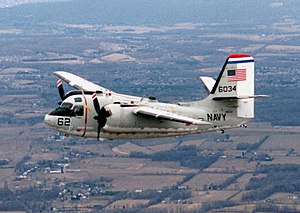| C-1 Trader | |
|---|---|
| A C-1A Trader from Naval Air Station, Willow Grove, Pennsylvania in 1987 | |
| Role | Transport |
| Manufacturer | Grumman |
| First flight | 4 December 1952 |
| Introduction | 1952 |
| Retired | 1988 |
| Primary user | United States Navy |
| Number built | 83 |
| Developed from | Grumman S-2 Tracker |
| Developed into | Grumman E-1 Tracer |
The Grumman C-1 Trader is a carrier onboard delivery (COD) variant of the Grumman S-2 Tracker. It was replaced by a similar version of the Northrop Grumman E-2 Hawkeye, the Grumman C-2 Greyhound.
Design and development[]
The C-1 Trader grew out of a need by the United States Navy for a new anti submarine airplane. In response to this Grumman began development on a prototype twin-engine, high-wing aircraft which it designated the G-89. In 1952 the Navy designated this aircraft the XS2F-1 and flew it for the first time on December 4 that year. During the rest of the 1950s three major variants emerged, the C-1 Trader being one of them. The C-1 (originally the TF-1) was outfitted to carry nine passengers or 3,500 pounds (1,600 kg) of cargo and first flew in January 1955.
Operational history[]
Throughout the 1960s and 1970s the C-1 Trader carried mail and supplies to aircraft carriers on station in the Pacific Ocean during the Vietnam War and also served as a trainer for all-weather carrier operations. Over its production life 83 C-1 Traders were built, of which four were converted into EC-1A Tracer electronic countermeasures aircraft. The last C-1 was retired from USN service in 1988; approximately ten are still airworthy in civil hands, operated as warbirds.[citation needed]
In August 2010, Brazilian Naval Aviation announced that it will buy and modernize eight C-1 to served in the carrier onboard delivery (COD) and aerial refueling roles for use on its aircraft carrier São Paulo.[1]
Variants[]

Grumman C-1 at Willow Grove

C-1A onboard USS Coral Sea
- TF-1
- Carrier Onboard Delivery version of the S-2 Tracker with enlarged fuselage for 9 passengers, redesignated C-1A in 1962, 87 built.
- TF-1Q
- Electronic Countermeasures conversion of the TF-1, redesignated EC-1A in 1962, four conversions.
- TF-1W
- Airborne Early Warning project that was developed in the WF-2 Tracer.
- C-1A
- TF-1 redesignated in 1962.
- EC-1A
- TF-1Q redesignated in 1962.
- KC-2 Turbo Trader
- Marsh Aviation modernization project for Air-to-Air Refueling, requested for the Brazilian Navy.[2]
Operators[]
Preserved aircraft[]
- C-1A C-1BuNo 136754 on static display at the National Museum of Naval Aviation, NAS Pensacola, Florida[3]
- C-1A BuNo 136790 on static display at the Grissom Air Museum, Grissom ARB (former Grissom AFB), Indiana[4]
- C-1A BuNo 136792 on static display at the Quonset Air Museum, (former NAS Quonset Point), North Kingston, Rhode Island. This aircraft was modified with the Grumman E-1 Tracer type radome assembly (but no radar) and twin tails and served (under the designation XTF-1W) as the aerodynamic prototype for the E-1. After testing, it reverted to the transport role, (as C-1A) with radome removed but retaining the twin tails. Throughout, this aircraft retained the S-2/C-1 upward folding wings, not the E-1 wing fold which were necessitated (by the radome atop the fuselage) to fold wings back along the sides of the fuselage.[5]
- C-1A Trader, BuNo 146034 on display at the Wings of Freedom Aviation Museum, former NAS Willow Grove, Horsham, PA[6]
- C-1A BuNo 146036 on display on the USS Midway Museum, San Diego, California,[7]
Specifications[]
General characteristics
- Crew: 2
- Length: 42.2 ft (12.9 m)
- Wingspan: 69.6 ft (21.2 m)
- Height: 16.3 ft (4.9 m)
- Empty weight: 18,750 lbs (8,504 kg)
- Max. takeoff weight: 29,150 lbs (13,222 kg)
- Powerplant: 2 × Wright R-1820-82WA Cyclone 9-cylinder radial piston engine, 1,525 hp (1,137 kW) each
Performance
- Maximum speed: 287 mph (462 km/h)
- Range: 1,300 miles (2,092 km)
See also[]
References[]
- ↑ Brazilian navy buys Traders
- ↑ "Brazilian Traders set for modernisation" Fight Global, 14 Dec 2011 Retrieved: 23 December 2011
- ↑ [1976.035.001] Aircraft - 'C-1A Trader'
- ↑ http://www.grissomairmuseum.com/airexib/planes/C1ATrader.html
- ↑ http://www.theqam.org/index.html
- ↑ http://www.wingsoffreedommuseum.org/index.php?option=com_content&view=article&id=61:grumman-c-1a-qtraderq&catid=38:fixed-wing&Itemid=66
- ↑ http://www.midwaysaircraft.org/acft/C1.htm
External links[]
| Wikimedia Commons has media related to Category:C-1 Trader. |
| ||||||||||||||||||||
The original article can be found at Grumman C-1 Trader and the edit history here.
